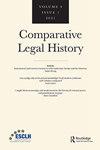Nordic inheritance law through the ages. Spaces of action and legal strategies
IF 0.5
Q2 LAW
引用次数: 1
Abstract
As the old adage goes, nothing is certain in this world but death and taxes. Perhaps the same also applies to inheritance law. From time immemorial, societies have had to respond to and deal with the death of its members: ‘where people live in society, there will be rules concerning succession’. Inheritance law constitutes one of the most basic and comprehensive fields for the regulation of society. By its nature, inheritance legislation is traditional, conservative and changes very slowly. Sometimes its regulations are even regarded as a legal order dictated by nature, history or a higher power, and as such almost impossible to change. New laws of inheritance are seldom issued, but in the Nordic countries, both Denmark and Norway have recently reformed their inheritance regulations. So perhaps now is an excellent opportunity to shed light upon the historical roots of inheritance law in the Nordic context. For a legal historian with an interest in family law, the anthology Nordic Inheritance Law through the Ages (hereinafter, Nordic Inheritance Law) is a most welcomed book. The anthology explores the significance of inheritance law from medieval times to the present through topical and in-depth studies that breathe life into historical and contemporary inheritance practices. The contributors to Nordic Inheritance Law, 16 in total, are a mixture of historians, legal historians and contemporary lawyers from Denmark, Finland, Iceland, Norway and Sweden. The anthology is an outcome of a Nordic interdisciplinary research project, hosted and financed by The Centre for Advanced Studies at the Norwegian Academy of Science and Letters in Oslo during the academic year 2014–5. In the Nordic countries, a region consisting of contemporary Denmark, Finland, Iceland, Norway and Sweden, inheritance law has not always been the most researched field in legal history, nor in contemporary jurisprudence for that matter. Previous research in legal history has focused foremost on medieval aspects of inheritance and inheritance law, and it is just in the last 20–30 years that light has been shed over other historical periods as well. The broad timespan of北欧的继承法。行动空间和法律策略
正如一句古老的谚语所说,在这个世界上,除了死亡和税收,没有什么是确定的。也许这同样适用于继承法。自古以来,社会就必须应对和处理其成员的死亡:“人们生活在社会的哪里,就会有关于继承的规则”。继承法是社会调节最基本、最全面的领域之一。从本质上讲,继承立法是传统的、保守的,变化非常缓慢。有时,它的规定甚至被视为一种由自然、历史或更高权力决定的法律秩序,因此几乎不可能改变。新的继承法很少颁布,但在北欧国家,丹麦和挪威最近都对其继承条例进行了改革。因此,也许现在是一个绝佳的机会,可以揭示北欧背景下继承法的历史根源。对于一位对家庭法感兴趣的法律历史学家来说,选集《穿越时代的北欧继承法》(以下简称《北欧继承法)是一本最受欢迎的书。该选集通过专题和深入的研究,为历史和当代的继承实践注入活力,探讨了从中世纪到现在继承法的意义。《北欧继承法》的贡献者共有16人,他们是来自丹麦、芬兰、冰岛、挪威和瑞典的历史学家、法律历史学家和当代律师。该选集是北欧跨学科研究项目的成果,该项目由奥斯陆挪威科学与文学学院高等研究中心于2014-2015学年主办和资助。在北欧国家,一个由当代丹麦、芬兰、冰岛、挪威和瑞典组成的地区,继承法并不总是法律史上研究最多的领域,在当代法学中也不总是如此。以前的法律史研究主要集中在继承法和继承法的中世纪方面,而正是在过去的20-30年里,其他历史时期的研究也有所进展。
本文章由计算机程序翻译,如有差异,请以英文原文为准。
求助全文
约1分钟内获得全文
求助全文
来源期刊
CiteScore
1.70
自引率
0.00%
发文量
20
期刊介绍:
Comparative Legal History is an international and comparative review of law and history. Articles will explore both ''internal'' legal history (doctrinal and disciplinary developments in the law) and ''external'' legal history (legal ideas and institutions in wider contexts). Rooted in the complexity of the various Western legal traditions worldwide, the journal will also investigate other laws and customs from around the globe. Comparisons may be either temporal or geographical and both legal and other law-like normative traditions will be considered. Scholarship on comparative and trans-national historiography, including trans-disciplinary approaches, is particularly welcome.

 求助内容:
求助内容: 应助结果提醒方式:
应助结果提醒方式:


